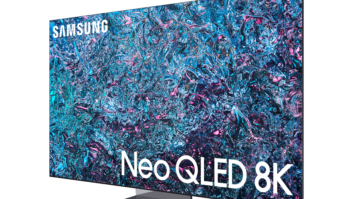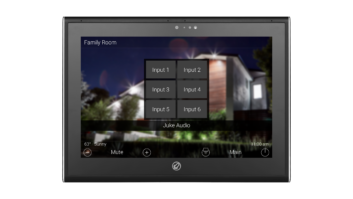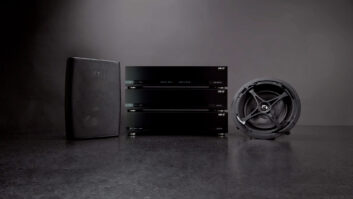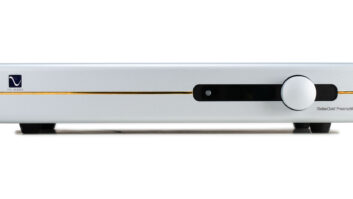I reserve my final day at International CES to wander through the Venetian where you can enjoy some of the finest collection of ultra-high-end audio systems gathered anywhere on the planet. It’s definitely not uncommon to walk into a suite and see a system using interconnects more expensive than a car, connected to speakers and electronics more expensive than most homes.
The Venetian is the haven to thick chunks of finely milled aluminum, military-grade silver windings, blocks of granite hewn into turntable plinths, and exotic materials like Beryllium crafted into the finest drivers, all painlessly handcrafted into products designed to get your ears as close to sonic nirvana as possible.
At the same time, there are some terrific audio values to be found in the Venetian as well. Companies that deliver terrific audio experiences at real world prices; products whose performance is made all the more impressive when you consider that they sell for literally fractions of the price of systems you’ve heard just moments before.
Here are some things at both end of the monetary spectrum that captured my eyes and ears at the Venetian.

Astrell Kern 380 Copper
At $4,000, the fully copper-clad Astrell & Kern AK380 is the luxury, gratuitous, over-the-top Vertu of portable music players. The player’s heft just screams LUXURY and high-end build quality and its design pedigree ensures that your music listening on the go will never be compromised. In fact, with dual AKM AK4490 DACs, and native DSD and 32bit/384kHZ support, it’s likely that the AK380 will far surpass the performance of most home systems. Fortunately the optional home dock provides dual fully balanced outputs to connect to your home amp or preamp so the good times never have to stop rolling.

Sennheiser Orpheus
Ok, while I didn’t hear these at the Venetian (Sennheiser was located in the South Hall of the LVCC) you really can’t talk about wanton, conspicuous high-end audio consumption without mentioning the most expensive headphones ever made. At $55,000, Sennheiser’s new Orpheus headphones are a sumptuous feast for both the eyes and ears. Pressing the front-panel button on the thick Italian marble base causes the top of the case to gently slide back and the eight tube amps to slowly rise into position and start glowing a gentle, warm orange, all the while a case lifts open to reveal the phones in their storage chamber. The Orpheus sound like strapping a buttery soft leather covered pair of Martin Logan electrostats onto your head revealing startling detail from every note.

Continuum Labs Turntable
This turntable from Continuum Labs carries a six-figure price tag, but it is just so amazingly cool, you’ll hardly notice that you had to mortgage your home to buy it. The player has a wonderful steampunk aesthetic while being the perfect mechanism of conveying every microcosm of information within a vinyl record’s grooves.

Martin Logan Neolith
Constellation Audio paired with Martin Logan to share technologies at CES this year, and Constellation had a gorgeous pair of Ferrari red colored Neolith towers in its suite. At nearly 6-foot 3-inches and 385 pounds, the $80,000/pair Neoliths are an imposing statement piece and gorgeous works of art when doing nothing more than just standing there. But when fed audio from the high-current Constellation Audio monoblocks, the Neoliths delivered a mammoth wall of sound that sounds like a band has set up in the stage which is your living room.

YG Acoustics
At more than $100,000/pair, the YG Acoustics Sofia 1.3 speakers have been called some of the greatest speakers ever made by some reviewers. Here they were driven by massive Boulder monoblock amplifiers. The sound was exceptionally detailed with low-end that was textured and tactile and fast, but without a hint of bloat.

TAD
One of my favorite high-end speaker manufacturers is Technical Audio Devices (TAD), Pioneer’s high-end audio division. This year—the company’s first CES since wizard designer Andrew Jones moved on—the company demonstrated a work-in-progress given the project name “White Carat.” The small, two-way bookshelf speakers produced a staggering amount of sound with incredibly rich detail and depth and a shocking amount of width to the audio presentation. White Carat utilize a new Beryllium tweeter design and will be the entry level in TAD’s line-up when they are (fingers crossed) a real product by next CES.

Paradigm Concept
While just a concept at CEDIA, the Paradigm Concept 4F (working title) will officially enter production and become the statement piece at the pinnacle of Paradigm’s speaker line-up. The 4F has a striking white appearance and features Paradigm’s newly designed TruExtend Beryllium 1-inch tweeters and 7-inch midrange drivers along with four ultra-high-excursion 8.5-inch woofers in a vibration cancelling configuration, with each woofer pair driver by separate DSP controlled 700-watt amplifiers. To keep all that bass in check, Anthem Room Correction calibrates just the low-end performance. The speakers were driven by Anthem M1 1,000-watt monoblocks and produced incredible dynamics and massive SPL’s without a hint of strain. As the speakers are yet-to-be-named, my suggestion is “THE Paradigm.”

Auro 3D
Auro 3D demonstrated its immersive audio system in a 9-channel array, having a demo disc that was filled with a variety of new content. While there are no Auro 3D encoded Blu-rays yet in the U.S. (interestingly, Sony Pictures released Pixels in Europe with Auro 3D and Dolby Atmos here in the States), the company feels confident that material will come. I’m looking forward to receiving a copy of the demo disc and installing the Auro 3D upgrade on my Marantz AV8802a processor and seeing how a traditional 7.2.4 speaker layout works with Auro 3D material. Look for an upcoming review…

GoldenEar Tech
At this point it’s a bit of a cliché to say that GoldenEar founder Sandy Gross has done it again when talking about new GoldenEar Technologies speaker designs, but, well, he has. When it comes to delivering phenomenal, five-figure performance, at shockingly affordable low four-figure budgets, few speaker companies can match GoldenEar, and this year the company refreshed two of its previous designs; the seven-year-old Triton Two and six-year-old Triton Three. Both models received updates and now feature a + designation. Sandy said his intention was to bring the sonic characteristics more in line with the company’s flagship Triton One towers, and to do that the speakers received new bass/mid drivers, a completely new balanced crossover, and completely reprogrammed DSP low-level control. I listened to the $2,500/pair Triton Three+ first and was blown away by the depth and dimensionality and just stomp-on-your-chest bass notes when the music called for it. Beck’s “Heart is a Drum” delivered tons of textural detail, extracting all the fine detail and reverberation as Beck plays the acoustic guitar, as well as the air, space and decay around the vocals. The speaker’s High-Velocity Folded Ribbon tweeters just love strings, cymbals, and delicate brush strokes and fine detail; essentially any notes that require the delicate handling of a microsurgeon and they handled Tsoyushi Yamamoto’s jazz trio playing “Misty” with great aplomb. While the $3,500/pair Triton Two+ had a bit more oomph on the low end, and would work well in larger rooms or with listeners that like to push the SPL meter up into the red zone, listening to the Two+ really made me appreciate how terrific the smaller Three+ really was.
Across the hallway in another GoldenEar suite, the company debuted its new Super Sub X. The relatively small sized, barely over a one-foot-cube package includes two 8-inch long-throw drivers and two 10×11-inch quadratic planar radiators, driven by a 56-bit DSP driven 1400-watt digital amplifier. The result is gobs of bass that feels like a V8 truck is driving over your chest! At the same time, the sub is detailed and subtle enough to produce distant thumping explosions as well as near-miss jump-in-your-seat mortar blasts. All this for $1,249.

Sony PS-HX500
With the resurgence of vinyl—there is a whole section in our Barnes & Noble!—among younger listeners, Sony looks to tap into this market and bridge the high-resolution gap between analog and digital. In that vein, the company’s new PS-HX500 turntable was one of the cooler real-world performance geared products I saw at CES. While it’s a fully functional, belt-driven turntable on its own with an analog output (and built-in phono EQ that can be defeated) that can feed any audio system, its real trick comes from its USB output which can connect to a computer to create an ultra-high resolution, exact digital capture of the album including all of the vinyl’s signature sound including any pops, clicks, or other record noise. The recording captures everything sent through the Moving Magnet cartridge in either native DSD (2.8 or 5.6 MHz) or WAV in resolutions up to 192/24. Once the album is captured, Sony’s software allows simple editing such as adjusting start and stop time to remove “needle drop,” track marking, and metadata labeling. The PS-HX500 will be available in April at a retail price of $600.

ELAC UniFi
#Truth: I only went to the ELAC booth because one of my very favorite speaker designers, Andrew Jones, recently left his position at Pioneer/TAD to come to work for ELAC. I heard that Andrew would be holding court in the Venetian suite and demonstrating the products he has been working on since joining the company. Andrew is no stranger to the world of stratospheric speaker designs, and I was expecting some new reference statement, but was shocked to hear that he was demonstrating something at the other end of the spectrum: a three-way bookshelf monitor that will retail for $500. Much like he did recently with lower priced Pioneer speakers, Andrew said he wanted to see what the next performance step up was from $250/pair and to really push the boundaries of what could be done with truly affordable audio. The new Uni-Fi UB5 includes a new custom-designed concentric driver that places a 1-inch soft dome tweeter in a rigid 4-inch aluminum cone midrange, capable of extending to frequencies out to 30k Hz. Equally stunning is the level of bass depth and detail Andrew manages to coax from the 5.25-inch aluminum woofers. The result is audio that is just OMG! on everything they played. It is the kind of audio listening epiphany that just leaves you sitting in your chair shaking your head and with a goofy smile on your face. If Andrew can do this at $500/pair, you only wonder what ELAC will have in store in the future…

Naim Mu-so Qb
If you think “stodgy, British audio” when you hear the word “Naim,” you wouldn’t be so far off. For years, Naim has been seated at the top end of stiff upper lips, and the company has the distinguished pedigree of being the audio system chosen as the premium in-cabin entertainment system for Bentley vehicles. Multi-room streaming audio might seem as unlikely to Naim’s heritage as the Queen ditching her morning cup of Earl Grey for a stiff double-shot of espresso. However, the company’s new Mu-so Qb breaks new ground for Naim in both price and features. With the grille off (as in the picture) the Qb resembles a kind of mildly upset Tiki god face, but the audio and controls will definitely bring a smile to your face. The top-mounted control ring features a knob that turns with ultra-smooth precision, reminding me of something that might control the temperature inside your Bentley Continental. The small cube is literally packed with technology including 300 watts of amplification powering five drivers. The system utilizes a 32-bit DSP engine to fine tune audio performance and streams a variety of audio formats up to 192/24-bit. On the streaming front Qb currently handles AirPlay, Spotify Connect, Tidal, and Bluetooth aptX and creates a wonderfully totally-in-sync distributed audio experience. Sonically the Qb is anything but reserved and stuffy, able to produce truly room filling sound with meaningful bass. You can Naim this tune for $1,000.

SVS Prime Elevation
Another company that’s no stranger to high-value performance is SVS Sound. Each year the company continues to wow and impress with entire surround systems that sell for less than a single cable being used in many other suites. This year the company was playing Atmos on a 5.1.2 system using its Prime Series speakers that retail for $2,500, proving you can have an immersive surround experience with soul-thumping bass without needing to cash in your stock options. During a demo using an Atmos-encoded scene from American Sniper you could practically feel the bullets zipping past your head, the concrete walls chipping and splintering around the room under the SEAL assault team’s breach. New from SVS is the Prime Elevation surround speakers that the company is calling, “The most versatile home theater speaker. Ever.” The speaker’s angled design allows it to be used in a variety of applications, including a down-firing height channel speaker in an Atmos/DTS:X install, up- or down-firing front or center speaker, side- or rear-firing surround speaker. Either way you place it, at a target price of $349/pair, the Elevation will make sure theaters of all budgets can enjoy terrific sound.

Bluesound MQA
MQA stands for Master Quality Authenticated, and it is a term you’re going to be hearing a lot. MQA is a “revolutionary end-to-end technology that delivers master quality audio in a file that’s small enough to stream or download” that is going to be supported by Tidal. The technology is designed to strip away all of the little sonic imperfections and blemishes added by the equipment used in the recording process, delivering “every nuance, every subtlety, every tiny drop of emotion” available as if you were standing in the recording studio with the artist. Developed by the digital geniuses at Meridian, MQA is now being incorporated by other manufacturers and one of the first products to get an MQA update will be Bluesound’s multi-room music system. I just finished a full review of the company’s Gen 2 Bluesound line-up and was super impressed. At CES I got to listen to a Vault 2 streaming MQA files including “Moondance,” a track from Van Morrison that I’ve listened to hundreds of times. Through the Vault 2 the MQA file had amazingly clarity, producing a textural quality to the strings and breathy reedy quality to the flute with detail I’d never experienced before. MQA will be available on all Bluesound components via an upcoming free firmware update.







